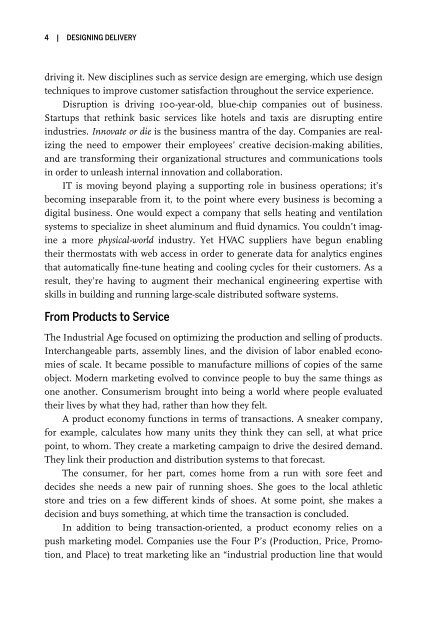Designing Delivery
1Tox6aC
1Tox6aC
Create successful ePaper yourself
Turn your PDF publications into a flip-book with our unique Google optimized e-Paper software.
4 | DESIGNING DELIVERY<br />
driving it. New disciplines such as service design are emerging, which use design<br />
techniques to improve customer satisfaction throughout the service experience.<br />
Disruption is driving 100-year-old, blue-chip companies out of business.<br />
Startups that rethink basic services like hotels and taxis are disrupting entire<br />
industries. Innovate or die is the business mantra of the day. Companies are realizing<br />
the need to empower their employees’ creative decision-making abilities,<br />
and are transforming their organizational structures and communications tools<br />
in order to unleash internal innovation and collaboration.<br />
IT is moving beyond playing a supporting role in business operations; it’s<br />
becoming inseparable from it, to the point where every business is becoming a<br />
digital business. One would expect a company that sells heating and ventilation<br />
systems to specialize in sheet aluminum and fluid dynamics. You couldn’t imagine<br />
a more physical-world industry. Yet HVAC suppliers have begun enabling<br />
their thermostats with web access in order to generate data for analytics engines<br />
that automatically fine-tune heating and cooling cycles for their customers. As a<br />
result, they’re having to augment their mechanical engineering expertise with<br />
skills in building and running large-scale distributed software systems.<br />
From Products to Service<br />
The Industrial Age focused on optimizing the production and selling of products.<br />
Interchangeable parts, assembly lines, and the division of labor enabled economies<br />
of scale. It became possible to manufacture millions of copies of the same<br />
object. Modern marketing evolved to convince people to buy the same things as<br />
one another. Consumerism brought into being a world where people evaluated<br />
their lives by what they had, rather than how they felt.<br />
A product economy functions in terms of transactions. A sneaker company,<br />
for example, calculates how many units they think they can sell, at what price<br />
point, to whom. They create a marketing campaign to drive the desired demand.<br />
They link their production and distribution systems to that forecast.<br />
The consumer, for her part, comes home from a run with sore feet and<br />
decides she needs a new pair of running shoes. She goes to the local athletic<br />
store and tries on a few different kinds of shoes. At some point, she makes a<br />
decision and buys something, at which time the transaction is concluded.<br />
In addition to being transaction-oriented, a product economy relies on a<br />
push marketing model. Companies use the Four P’s (Production, Price, Promotion,<br />
and Place) to treat marketing like an “industrial production line that would


